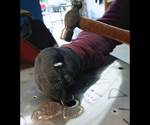Under the Scope: Communication and Workflow
Closing the communication gap ensures that everyone involved is on the same page, allowing for an efficient and timely repair process.
Communication helps a mold welder avoid critical welding mistakes, and direct access to the project manager to discuss the intricacies of each job is key. This relationship is vital for determining exactly which areas need to be welded, as well as which areas should not be welded. I use a pointer and a magnifying lens as part of any discussion and inspection of a weld job. This allows me to pinpoint specific aspects of the job. This type of communication makes the process transparent and ensures a successful mold repair.
Unfortunately, the scenario I just described does not often happen for many reasons, including logistics. For example, someone in the shipping department may deliver the mold instead of the person directly in charge of the project, the welder may not be able to reach the appropriate person to get answers to questions, inaccurate directions might be issued to the welder, or the toolroom department might provide one set of instructions and the engineering department might send another. These are all daily, real-world situations that complicate mold repair jobs.
Here are a few ways to close the communication gap. The goal is to get everyone involved on the same page in order to make the repair process efficient and timely.
Make sure you have accurate contact information. If possible, try to get the emails, direct telephone extensions and even the cellphone numbers of the toolroom supervisor and lead engineer. Learn their schedules, including the hours they work, their lunchtimes and even their weekly meeting times. This information is critical when you need to contact someone quickly.
Request further information if you are unsure. If you do not believe you have a complete understanding of what you need to do, always call the main contact person for further clarification. This applies specifically to engineering changes in molds, since often these involve design revisions and not actual damage. I rarely work on assumptions when welding unless the area to be welded is completely obvious. Even then, I may encounter something that does not look right and needs further clarification.
Ask pointed questions. During the inspection phase, you want to know exactly what needs to be welded. If it is an engineering change, find out what will be the end result of the weld after it is machined. This allows you to adjust the weld buildup accordingly. Most importantly, when a customer dictates how much weld buildup he needs, always ask how much he needs to finish after machining. This is so the welder can give more weld than the customer actually requests to ensure it cleans up after machining. For example, if the customer requests 0.020 inch of weld buildup, I will provide slightly more than he needs. Asking the customer for his finishing dimensions allows the welder to give him exactly what he needs without any unnecessary weld buildup.
Appropriately handle departments and personnel. In my experience, the larger the company, the less its departments communicate with each other. For example, the toolroom may call to inform you that it has an emergency repair coming that it must wait for, and the shipping department will drop off the job and say it cannot wait for the job to be completed. This is why it is so important to know the main contact person in each department and develop relationships. This creates a direct line of communication to avert any problems.
Be accountable. In my shop, all jobs are examined thoroughly. I check everything, even the quantity of parts I receive against the quantity listed on the purchase order. I follow up on any discrepancies immediately and with
the appropriate person. When I am working on a project and notice microscopic cracks in details and areas with more damage than described, I discuss this with the customer before beginning any welding.
The welding process changes the steel chemically and structurally, so you need to be sure what you are doing is clear to the customer. The goal is to minimize any chance of mistakes as a result of miscommunication among all parties involved.
Related Content
How to Use Thermal Management to Improve Mold Cooling
A review of common mold cooling issues and possible solutions, including 3D printing applications.
Read MoreProducts and Services for Multiple Moldmaking Needs
New year, new technology roundup! Featured here is a collection of product offerings, from profile milling cutters to industry-specific CAD/CAM software to innovative hot work tool steels.
Read MoreMoldMaking Technology's Most-Viewed Content 2022: Products
MMT shares the five top-viewed technologies, equipment and services of 2022 in each Engineer, Build, Maintain and Manage tenet based on Google Analytics.
Read MoreThe Ins and Outs of Hot Runner Temperature Control
A training checklist that explains the why and how of proper hot runner temperature control and system management.
Read MoreRead Next
Under the Scope: Cracking Demystified
Cracking in tool welding is a common challenge, but it is one for which risk can be minimized.
Read MoreHow to Use Continuing Education to Remain Competitive in Moldmaking
Continued training helps moldmakers make tooling decisions and properly use the latest cutting tool to efficiently machine high-quality molds.
Read MoreAre You a Moldmaker Considering 3D Printing? Consider the 3D Printing Workshop at NPE2024
Presentations will cover 3D printing for mold tooling, material innovation, product development, bridge production and full-scale, high-volume additive manufacturing.
Read More.jpg;maxWidth=970;quality=90)









_300x250 1.png;maxWidth=300;quality=90)















